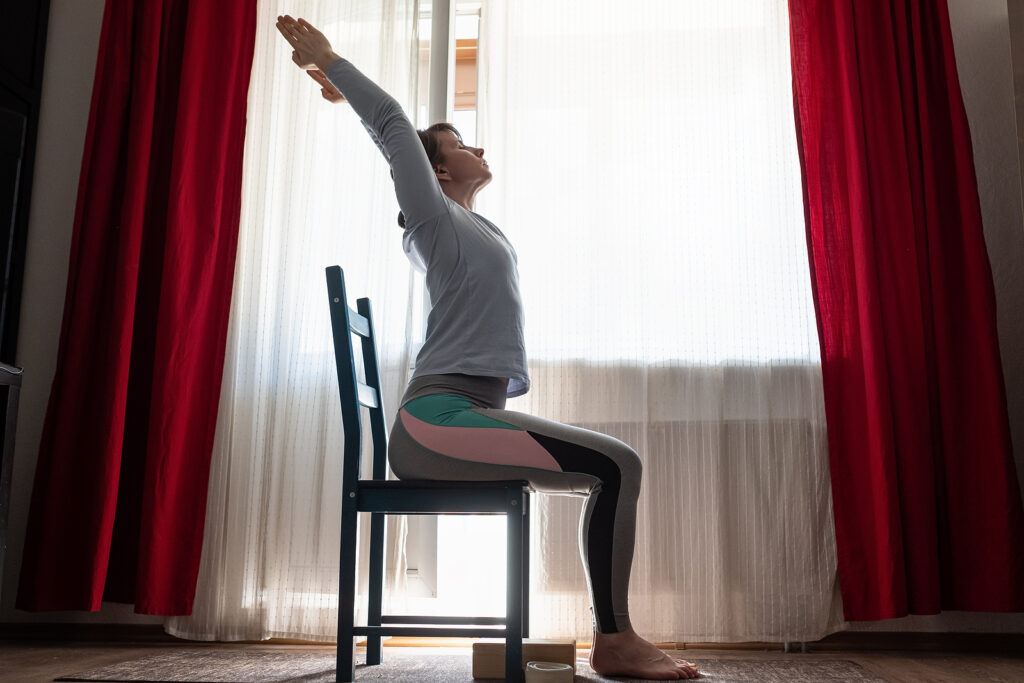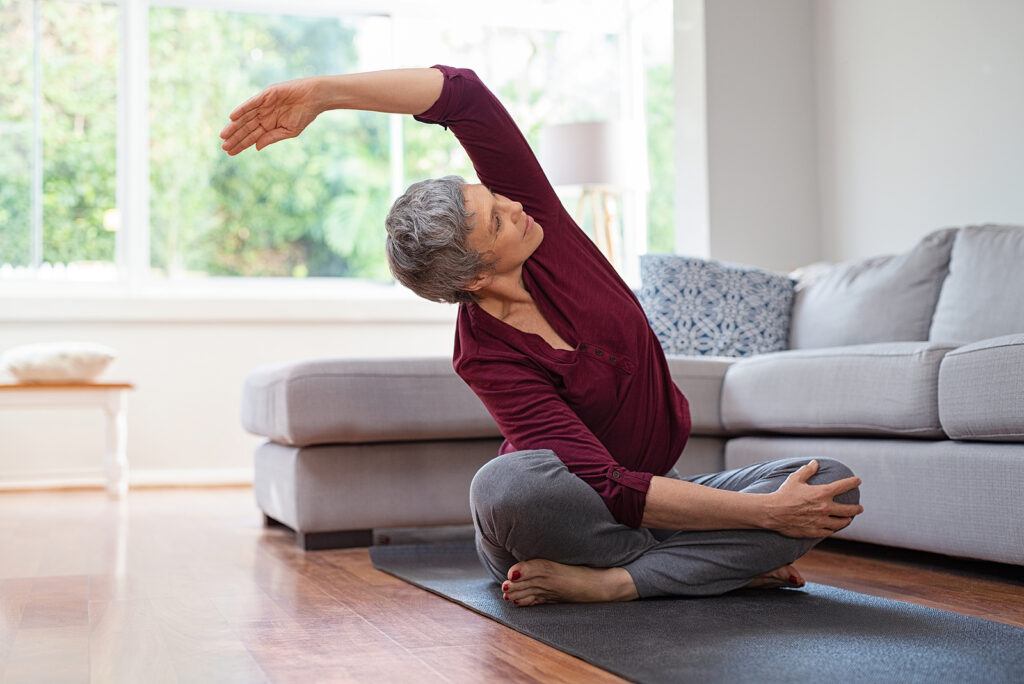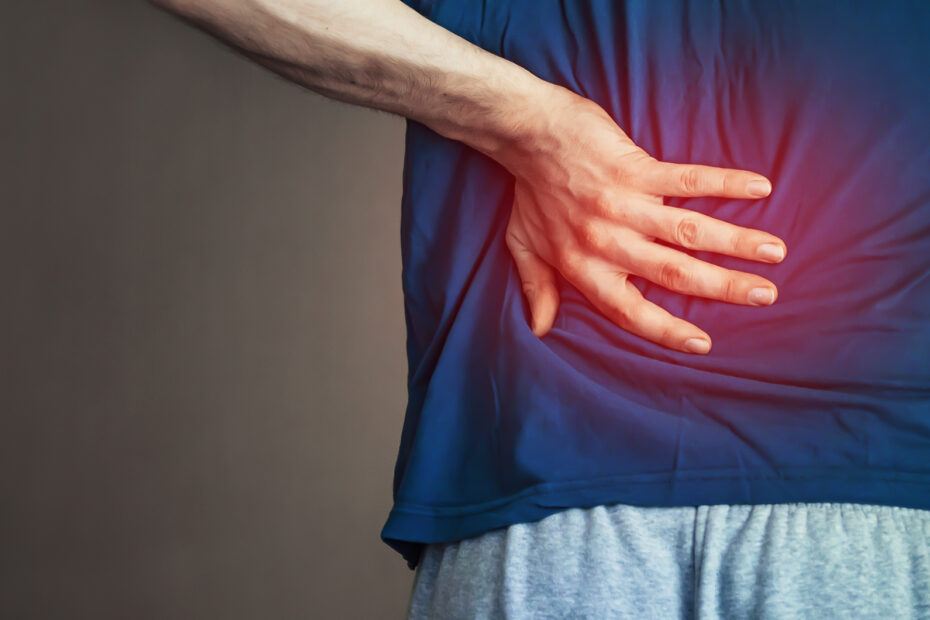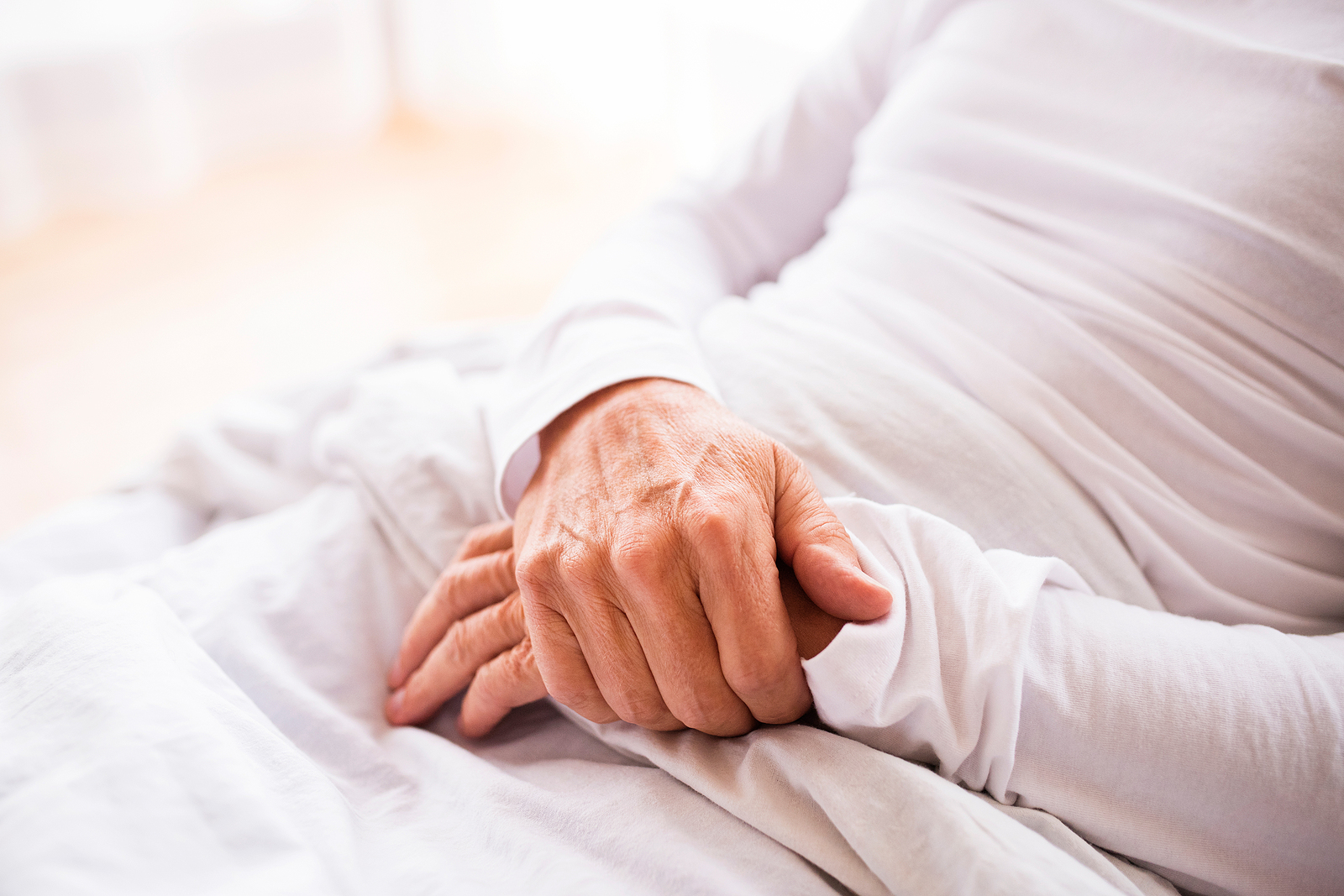As we age, maintaining a healthy lower back becomes increasingly important for mobility, posture, and reducing pain.
It also becomes increasingly difficult.
A lot of seniors experience discomfort in the lower back due to age-related changes, but muscle weakness and poor posture can play big roles too.
Fortunately, there are plenty of exercises we can do to help protect our backs as we age, many of which can be done from a comfortable seated position.
Seated exercises are great because they’re safe for most seniors and can be an effective way to strengthen and stretch the lower back (without putting undue strain on the body).
In this article, we’ll discuss some of the best seated low back exercises that can help seniors alleviate discomfort and improve overall spine health.
But let’s start with a quick review on some of the most common causes of back pain.
What Causes Low Back Pain?
Low back pain is a common issue for many seniors, often arising from a combination of age-related changes, lifestyle factors, and underlying health conditions.
Understanding the root causes of low back pain can help in managing and preventing it more effectively.
Here are some of the most common reasons seniors experience low back pain:
Age-Related Degeneration
As we age, the spine naturally undergoes wear and tear.
The intervertebral discs, which act as cushions between the bones (vertebrae) in the spine, tend to lose water content and elasticity over time.
And this degeneration can lead to conditions like degenerative disc disease or spinal stenosis, both of which can cause chronic back pain, stiffness, and reduced mobility.
Osteoarthritis
Osteoarthritis is a condition in which the protective cartilage in the joints wears down over time, which can lead to pain, swelling, and reduced flexibility.
When it affects the spine, it can cause lower back pain and stiffness, particularly in the morning or after periods of inactivity.
The breakdown of cartilage between the vertebrae can lead to pain as well as a generalized feeling of stiffness.
Muscle Weakness/Tightness
With aging, muscle mass and strength naturally decrease, a condition known as sarcopenia.
This can lead to muscle imbalances, particularly in the core and back muscles, which are responsible for supporting the spine.
Weak or imbalanced muscles can put extra strain on the lower back, leading to pain, fatigue, and an increased risk of injury.
Lack of activity (or poor posture) can lead to tight muscles in the low back, which can also be a potent source of pain.

Poor Posture
Years of slouching or poor posture can also contribute to chronic low back pain.
Over time, poor posture puts strain on the spine, leading to misalignment and stress on the lower back muscles and joints.
Seniors who spend long periods sitting without proper lumbar support or standing with poor posture may experience ongoing discomfort in the lower back.
Sciatica
Sciatica occurs when the sciatic nerve, which runs from the lower back down the legs, becomes compressed or irritated.
This can cause pain that radiates from the lower back through the hips and down the leg, often making it difficult to walk or move comfortably.
Herniated discs or spinal stenosis are common causes of sciatica in seniors, but tightness in the hip muscles can also cause sciatic symptoms.
Osteoporosis
Osteoporosis is a condition that weakens bones, making them brittle and more susceptible to fractures.
Compression fractures in the vertebrae can occur as a result of osteoporosis, leading to significant back pain.
These fractures may happen even from minor falls or sudden movements, making osteoporosis a major concern for seniors with low back pain.
How Can Exercise Help?
The lower back plays a huge role in supporting your spine and enabling movement, but it also helps stabilize your body during everyday activities.
So keeping the muscles around your back strong and mobile offers several benefits for seniors:
- Improved Posture: Strong back muscles support proper alignment of the spine, which can help reduce slouching and prevent back pain.
- Pain Relief: Strengthening and stretching the lower back can help alleviate chronic pain caused by conditions like arthritis, sciatica, and degenerative disc disease.
- Enhanced Mobility: A strong lower back makes it easier to perform daily activities, such as standing up from a chair, reaching for objects, and walking.
- Reduced Fall Risk: A well-supported spine and core contribute to better balance, stability, and coordination, reducing the likelihood of falls.
Exercise can have a direct impact on the muscles around your core, but keeping your spinal joints moving is beneficial as well.
Arthritis can be tough to deal with, but keeping those joints moving within as pain-free a motion as possible is one of the best things you can do.
In other words, movement is always a good thing.
6 Effective Seated Low Back Exercises for Seniors
1. Seated Pelvic Tilts
Pelvic tilts are a simple yet effective exercise to get your lumbar spine moving and to strengthen the muscles in your lower back and core.
- Sit up straight in a sturdy chair with your feet flat on the floor
- Place your hands on your thighs or the sides of the chair for support
- Slowly tilt your pelvis forward, arching your lower back slightly, then tilt it backward, rounding your lower back (and contracting your abs)
- Repeat this motion for 10-15 repetitions
Check out this YouTub video for a demonstration.

2. Seated Cat-Cow Stretch
The seated cat-cow stretch, adapted from yoga, is excellent for increasing flexibility in the spine and relieving lower back tension.
Just be careful and avoid moving past your comfort zone – you don’t want to feel much pain.
- Sit tall in your chair with your feet flat on the floor and your hands resting on your thighs
- Inhale and arch your back, lifting your chest toward the ceiling (this is the “cow” position)
- Then, exhale and round your back, pulling your belly button toward your spine and tucking your chin toward your chest (the “cat” position)
- Repeat this movement 5-10x
This is a great exercise for your thoracic spine and posture as well.
It’s traditionally done from a quadruped position (on your hands and knees), but this seated variation is a nice alternative for seniors who can’t comfortably get in that position.
Check out this YouTube video for a demonstration.
3. Seated Forward Bend
The seated forward bend gently stretches the lower back, which can help relieve tension and improve flexibility.
It’s also helpful for promoting an anterior lean during sit-stand transfers, which can come in handy for seniors who struggle with getting out of a chair.
- Sit on the edge of your chair with your feet flat on the floor and slightly apart
- Slowly lean forward from your hips, reaching your hands toward your feet
- Let your head and neck relax as you stretch your lower back
- Hold the position for 10 seconds, then slowly sit back up
- Repeat 3-5x
This is a gentle stretch that usually feels pretty good, but just be careful with returning back up to the sitting position – take your time to help avoid pulling something in your back.
Check out this YouTube video for a demonstration.
4. Seated Trunk Rotation
Trunk rotations are great for stretching and strengthening the muscles along the spine, including the lower back and core.
Rotational movements are also good for our heads because they keep our inner ear (vestibular system) stimulated.
- Sit with your feet flat on the floor and your back straight
- Place your hands together straight out in front (or crossed over your chest)
- Gently rotate as far as you can comfortably go to one side, pause, and then rotate to the other side
- Repeat 10x to each side
If possible, performing this exercise with your back unsupported will force your core stabilizers to work a little harder.
Check out this YouTube video for a demonstration.
5. Seated Figure-4 Stretch
This is a great stretch for the muscles in the back of your hips (glutes, piriformis) and this one can be super helpful for seniors dealing with sciatica.
But it’s also good for tight hips and really any other low back or sacral pain.
- Sit up straight with your feet flat on the floor
- Slowly lift your right leg and place your right foot across your left knee
- You may feel a stretch in this position alone, but if necessary, you can add a little pressure to the right knee for additional stretch
- Hold for 20-30 seconds and then switch to the other side
- Repeat 3-4x for each leg
For more flexible seniors, you can lean forward (from the hips, keeping your back straight) while in the figure-4 position for an even deeper stretch.
Check out this YouTube video for a demonstration.

6. Seated Side Bends
Side bends target the muscles along the sides of your lower back, helping to improve flexibility and reduce tension.
- Sit with your feet flat on the floor and your arms at your sides
- Slowly reach your right hand down toward the side of your chair, bending at your waist
- Hold for 5-10 seconds and then gently return to the starting position
- Repeat on the left side
- Perform 8-10 bends on each side
You should feel a gently stretch on the side of your low back for this one (between your rib cage and hip bone).
Depending on how tight you are, you may not have to side bend that far to feel a stretch, so don’t feel like you have to go really far for this one.
For an additional stretch, you can reach your opposite hand overhead as you bend down to the side.
Check out this YouTube video for a demonstration.
Safety Precautions When Exercising
While seated low back exercises can offer numerous benefits for seniors, it’s essential to approach these movements with care to avoid injury and ensure a safe, effective workout.
Here are some key safety precautions to keep in mind when performing these exercises:
1. Consult with Your Doctor First
If you’re unsure about your ability to perform any of these exercises, it’s a good idea to talk to your doctor first.
This is especially true if you have a pre-existing condition or severe back pain that could limit your ability to exercise.
Your healthcare provider can provide guidance on which exercises are safe for you and how to modify them to suit your needs.
And when in doubt, you can always request a physical therapy consult for additional guidance.
2. Use Proper Posture
Maintaining proper posture during seated exercises is crucial for protecting your lower back.
Sit up tall with your feet flat on the floor and try to maintain a nice, upright posture throughout.
Avoid slouching or rounding your back, as this can increase strain on your spine and lead to discomfort.
3. Start Slowly and Gradually Increase Intensity
If you’re new to exercising or haven’t been active in a while, it’s important to start slowly.
Perform each exercise with controlled, gentle movements and avoid sudden, jerky motions. Begin with fewer repetitions and gradually increase as your strength and flexibility improve.
Pushing yourself too hard, too quickly can lead to injury or muscle strain.
4. Avoid Pain
It’s normal to feel a mild stretch or slight discomfort when working muscles that haven’t been exercised in a while, but you should never experience sharp pain.
If you feel pain during an exercise, stop immediately and try a gentler movement.
Pain could indicate that the exercise isn’t appropriate for your body, or it could signal a potential injury.
Now muscle soreness after exercising shouldn’t be a cause for alarm, as this is a normal part of exercising (especially if you haven’t exercises for a while).
Working new muscles in a new way can cause soreness, but it shouldn’t last more than 2-3 days.
If you have lasting soreness for longer than this, you may want to dial down the intensity.
5. Use a Stable Chair
Make sure you’re using a sturdy chair that provides good support and won’t tip over during your exercises.
Ideally, the chair should have a firm seat and a backrest for support – avoid using chairs with wheels or uneven surfaces, as these can increase the risk of slipping or falling.
6. Breathe Properly
Remember to breathe throughout each exercise.
Holding your breath can increase tension in your muscles and reduce the effectiveness of the movement.
Practice slow, deep breathing to relax your body and support oxygen flow to your muscles.
7. Listen to Your Body
Everyone’s body responds differently to exercise.
Pay attention to how you feel during and after your workouts. If you feel overly fatigued, experience lingering pain, or notice that certain movements cause discomfort, take a break or modify the exercise.
It’s okay to go at your own pace and adapt exercises to suit your ability level.
Final Thoughts
Seated exercises can offer a safe and effective way for seniors to strengthen and stretch their low back muscles.
Which can be potent strategies when it comes to improving flexibility and reducing pain.
By adding these gentle movements into your daily routine, you can enhance your mobility and reduce the risk of debilitating pain.
Remember, consistency is key to seeing improvements in strength and flexibility.
Start with these exercises a few times a week, and always listen to your body—if any exercise causes discomfort, modify the movement or stop.
As always, consult with your healthcare provider before beginning any new exercise program to ensure it’s appropriate for your needs and health conditions.
With these seated exercises, you can take a proactive approach to maintaining a strong and healthy lower back for years to come!
Well, that about does it.
I hope you found this guide helpful and if you have any comments or questions, just leave ’em below and I’ll get back to you shortly.




About halfway down the article, right before it lists the exercises, there’s a sub heading “7 Effective Seated Low Back Exercises for Seniors” but there are only 6 exercises listed? What’s the 7th?
Ahh, that’s a typo I should’ve caught while editing, I only included 6 exercises… it’s been corrected. Thanks for the heads up and thanks for reading!